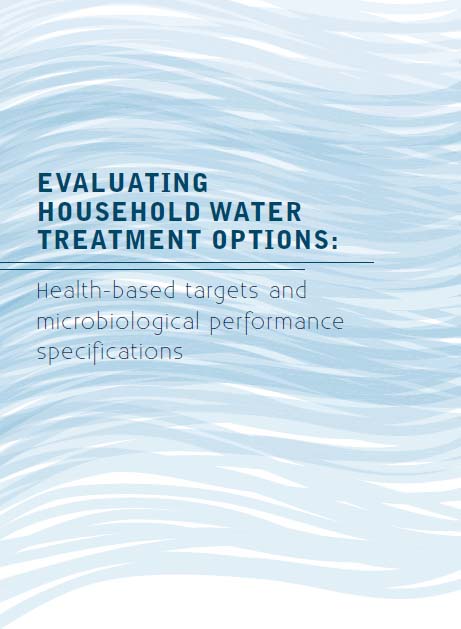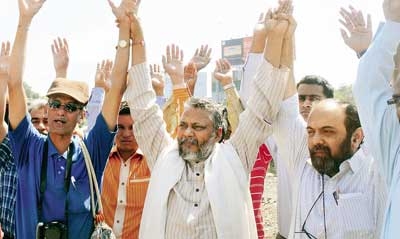/topics/biological-pollution
Biological Pollution
Evaluating household water treatment options
Posted on 17 Jul, 2011 02:11 PM This document by the World Health Organisation, for the first time, sets forth global criteria to evaluate whether a household water treatment option reduces waterborne pathogens sufficiently to protect health. Through use of a risk-based framework and by emphasizing the philosophy of incremental improvement, it is intended to provide implementers and policy-makers with an evidence-based and pragmatic approach to select options suited to local conditions.
This document by the World Health Organisation, for the first time, sets forth global criteria to evaluate whether a household water treatment option reduces waterborne pathogens sufficiently to protect health. Through use of a risk-based framework and by emphasizing the philosophy of incremental improvement, it is intended to provide implementers and policy-makers with an evidence-based and pragmatic approach to select options suited to local conditions.
Household water treatment interventions may play an important role in protecting public health where existing water sources, including those delivered via a piped network or other improved sources, are untreated, are not treated properly or become contaminated during distribution or storage. Household water treatment applications are a range of technologies, devices or methods employed for the purposes of treating water at the household level or at the point of use in other settings, such as schools, health-care facilities and other community locations. Point-of-use water treatment is another term used for household water treatment.
Bamboo charcoal as a natural Water Filter - An indigenous rural application
Posted on 16 Jul, 2011 07:24 PMGuest post: Shwetha Kamath (India Water Portal Volunteer)
About 74 per cent of India's total population, currently about 1.25 billion, live in rural areas. More than one third of the water available to them is not potable. In a grim reminder that poor quality of drinking water leads to serious health problems, India has admitted that about 180,000 rural populated areas are afflicted by diseases which are caused due to impure, toxic organic and inorganic substances including tri-halo methane, chlorine, etc. Some states have reported multiple contaminations in drinking water and there is no doubt that the current water situation in India will get much, much worse unless suitable solutions are sought. Most existing purification methods not only remove the impurities but drain out the essential minerals as well. Moreover, they are expensive and require extensive maintenance. Thus a natural filter comprising of bamboo, gravel, pebble and other locally available natural adsorbents is a great alternative to carry out water purification. What makes this filter unique is the use of bamboo charcoal which is not commonly used in any filter designed for domestic purposes.
Multi-district assessment of water safety (M-DAWS) in Gujarat - A study by Water and Sanitation Management Organisation
Posted on 15 Jun, 2011 12:08 PMThis report by the Water and Sanitation Management Organisation (WASMO) is based on the analysis of Multi-District Assessment of Water Safety (M-DAWS) carried out in 8 districts of Gujarat (Vadodara,Valsad, Mehsana, Gandhinagar, Kachchh, Surat, Ahmedabad and Dangs) , where ensuring adequate and safe drinking water to the people has been looked upon as a huge challenge needing urgent action during years 2007 and 2008 .
The Multi-District Assessment of Water Safety (M-DAWS) programme was undertaken by Water and Sanitation Management Organisation (WASMO) with financial and technical support from UNICEF.
Accessing safe drinking water during floods in North Bihar
Posted on 13 Jun, 2011 03:23 PMThis season in the region is commonly referred to as – Barh (flood). For centuries local people have treated it as ‘a way of life’, and found ways to deal with it. Post independence, this ‘way of life’ gradually transformed into an assured annual devastation. The once self-sufficient communities in the flood plains have been relegated to being highly dependent on sources external to the village for their survival during floods.
Study of water supply & sanitation practices in India using geographic information systems - Some design & other considerations in a village setting - IJMR research paper
Posted on 06 Jun, 2011 05:01 PMThe study attempted to understand the phenomenon of water contamination in the village by using GIS as a tool to locate and map water supply and sewage distribution systems in the village, in relation to human and animal dwellings, their wastes, sanitary practices and their connections with drinking water quality for a clearer understanding of the connections between these factors and possible
Drinking water quality monitoring and development of surveillance mechanisms - A pilot study done by NEERI in New Delhi
Posted on 20 Apr, 2011 02:30 AMThe WHO guidelines for drinking water quality aim to protect public health and the key way to ensure this is through the adoption of Water Safety Plans (WSP). WSP includes setting of health targets, risk analysis and its assessment to identify priority hazardous scenarios and management of the risk.
Dissemination of NDM-1 positive bacteria in the New Delhi environment and its implications for human health - An environmental point prevalence study published in The Lancet Infectious Diseases (2011)
Posted on 13 Apr, 2011 03:15 PMPlasmid-encoding Carbapenemase-resistant Metallo-B-Lactamase (PCM or NDM-1) is an enzyme that makes bacteria resistant, not only to a broad range of antibiotics such as carbapenems and other β-lactam, but also to multiple other antibiotic classes, leaving very few treatment options available, when a person gets infected with such bacteria.
Indian standard code of practice for installation of septic tanks (IS: 2470) - Bureau of Indian Standards (1986)
Posted on 11 Apr, 2011 03:46 AMThis IS Code provides various requirements that have to be met while constructing a septic tank, so that it meets minimum standards. This Code is dictated by the Bureau of Indian Standards, and ensures that the sewage is treated in a way that maintains health and hygiene of the community.
While the first standard for small septic tanks was first printed in 1963 and then revised in 1968, the standard for disposal of effluent from septic tanks was published later in 1964 and revised in 1971.
This code has been sourced through City Managers' Association Karnataka (CMAK), a non profit that provides technical expertise to urban local bodies.
Water pollution in villages - A post in Hindi by Ram Naresh Kumar and Sanjay Singh
Posted on 05 Apr, 2011 02:49 PMगांवों में जल प्रदुषण






